|
|

These topics describe tasks for working with devices and their interfaces.
The devices managed by QPM-PRO can be routers, switches, layer 3 switches, and LocalDirector. These devices must run a software version that supports QoS capabilities.
These topics describe the QPM-PRO tasks for devices:
You must add a device to the QoS database before you can configure the QoS settings for the device or its interfaces. Supported features include OS Detection and IOS Mapping and Device System Name.
QPM-PRO uses the device IOS version number to load device capabilities to the database. All sub-versions of a certain version are translated to the major version, unless QPM-PRO explicitly supports the minor version. In QPM-PRO, new minor versions are mapped to the last, supported minor version and not to the major version.
Both the device software version and the mapped software version are displayed in the Device Properties window:
The device system name can be defined in the device configuration and can be used instead of the device's IP address. The device system name is detected during the Verify Device Info operation while defining a device in the database. The device system name is added to the Device Properties window.
You can define your tree view by IP address/DNS name or by device system name, if it is configured.
Obtain this information for each device you are adding.
If the device is offline, you also need this information.
Step 1 From the Policy Manager, select Devices>Device>New, or right-click in the tree view and select New Device. QPM-PRO opens the New Device window.
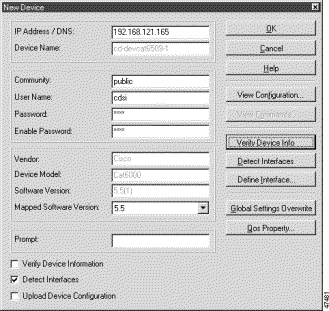
Step 2 Fill in the New Device window fields:
See the "New Device and Device Properties Dialog Boxes" section for more information.
Step 3 If the device is online, ensure that Verify Device Information and Detect Interfaces are selected and click OK. (Or, you can click the Verify Device Info button, and then the Detect Interfaces button, to accomplish the same thing). If you want to upload existing QoS configurations from devices that are already in the policy database, select Upload Device Configuration. See Uploading Device QoS Configurations for more information. Click Global Settings Overwrite to change global settings or enable/disable write memory after deployment. See Viewing or Changing Device Properties for more information.
QPM-PRO queries the device for its software version and model information, then queries the device for a list of interfaces and their configuration information. When the device has returned the interface information, QPM-PRO opens the Detect Interfaces window if appropriate. For some devices, you cannot configure specific interfaces, so QPM-PRO does not show you the list of device interfaces.
Step 4 In the Detect Interfaces window (if QPM-PRO opens it), ensure the interfaces you want to manage are in the list of selected interfaces, and remove any interfaces that you do not want to manage from the list. Click OK when finished.
QPM-PRO creates a folder for the device in the tree view using the name of the device. The device interfaces are included as members of this folder. Interface description, if it exists in the CLI, is retrieved in the Detect Interface operation. All interface information, including interface description, is shown in the interface preview in the lower part of the screen when the interface is selected.
Using QPM-PRO, you can upload the existing QoS configurations on devices when you add them to the policy database or before you make a QoS configuration change. This is useful if you install QPM-PRO on a system where you already have devices defined. Instead of redefining the device characteristics, you can use the upload feature to automatically update the QPM-PRO database with device information when you add the device.
 |
Note You can upload device configuration one time only. The Upload Device Configuration check box is disabled in the Device Properties window after you make QoS configuration changes to the device. |
The Upload Process incorporates the following steps:
In the case of defining exactly the same policy on several interfaces, a duplicate resource is created.
After upload is completed, an HTML report is generated. (See Figure 6-2 for a sample report.) This report logs all the QoS configurations that were not successfully uploaded to the database. Upload failure may be caused by incomplete configurations that exist on the router or unsupported options.
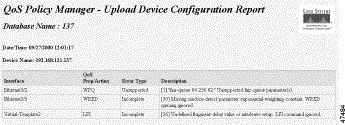
The column headings are as follows:
The following is a complete list of error messages that you will see in the Upload Device Configuration Report:
Error Message [1] "<parameter string>:" Unsupported fair-queue parameter(s).
Explanation QPM-PRO ignores parameter(s) and treats command as WFQ.
Recommended Action None.
Error Message [2] Unsupported device model <model> and QoS technique for IOS software release <release number>.
Explanation QPM-PRO does not support this particular model/IOS software release combination.
Recommended Action None.
Error Message [3] "<command string>:" Command not supported.
Explanation Unsupported command
Recommended Action None.
Example (Under class_map)
match mpls experimental
Error Message [4] "<command string>:" ToS-Based WFQ not supported. Flow-Based WFQ configured.
Explanation QPM-PRO supports flow-based WFQ,
Recommended Action None.
Error Message [5] map-class frame-relay <command string>: "<command string>" command not supported.
Explanation This particular frame relay command is not supported by QPM-PRO.
Recommended Action None.
Example map-class frame-relay fecn-adapt
Error Message [6] route-map <route-map command> seq-no <sequence number>: "<command string>" command not supported.
Explanation QPM-PRO does not support this route-map command.
Recommended Action None.
Example route-map QPM_Serial8 permit 1
match ip address 144
match length 2000 3000 <== Unsupported command
set ip precedence critical
Error Message [7] class-map <class-map command>: "<command string>" command not supported.
Explanation QPM-PRO does not support this class-map command
Recommended Action None.
Error Message [8] Cannot assign rule to default queue <queue number> in custom-queue-list <custom-queue-list name>. "<command string>" command ignored.
Explanation QPM-PRO does not support a filter on the default queue.
Recommended Action None.
Example access-list 101 permit tcp any any
access-list 102 permit udp any any
access-list 103 permit ip any any
queue-list 4 protocol ip 1 list 103
queue-list 4 protocol ip 2 list 102
queue-list 4 protocol ip 3 list 101 <== Ignored command
queue-list 4 default 3
queue-list 4 queue 1 byte-count 9000
queue-list 4 queue 2 byte-count 12000
queue-list 4 queue 3 byte-count 39000
Error Message [9] Multiple rules found in queue <queue number> in custom-queue-list <custom-queue-list>. "<command string>" command ignored.
Explanation Same queue with multiple rule listings. QPM ignores duplicate filters.
Recommended Action None.
Example access-list 101 permit tcp any any
access-list 102 permit udp any any
access-list 102 permit ipany any
queue-list 4 protocol ip 1 list 103
queue-list 4 protocol ip 2 list 101
queue-list 4 protocol ip 2 list 102 <== Ignored command
queue-list 4 default 3
queue-list 4 queue 1 byte-count 9000
queue-list 4 queue 2 byte-count 12000
queue-list 4 queue 3 byte-count 39000
Error Message [10] "<command string>:" ACL command for the corresponding number <number> not found.
Explanation Specified access list is not defined.
Recommended Action Redefine this policy in the database.
Error Message [11] "<command string>:" Unsupported buffer-limit=[<number>], default value: 1000.
Explanation Parameter buffer limit ignored. The default of 1000 is applied.
Recommended Action None.
Error Message [12] class-map <command string>: ACL command for the corresponding number <number> not found.
Explanation Specified access-list is not defined.
Recommended Action If you require this policy, redefine it in the database.
Error Message [13] priority-list <number> queue <number>: ACL number missing.
Explanation ACL number for the priority-list is missing.
Recommended Action If you require this policy, redefine it in the database.
Example priority-list 1 protocol ip high list 102 <== Missing number
Error Message [14] priority-list <number> queue <number>: ACL command for the corresponding number <number> not found.
Explanation Specified access list is not defined.
Recommended Action If you require this policy, redefine it in the database.
Error Message [15] Cannot locate priority-queue-list <command string>. Priority queuing ignored.
Explanation There is no definition for the priority-list that corresponds to the group number under the device.
Recommended Action Define priority-list.
Error Message [16] custom-queue-list <command string> queue <number>: Missing filter for the corresponding queue number.
Explanation Missing filter for the queue.
Recommended Action Define a custom-queue-list.
Example queue-list 1 protocol IP 1 list 114 <== Missing number
Error Message [17] custom-queue-list <command string> queue <number>: Protocol <protocol> not supported.
Explanation QPM-PRO only supports IP protocol type.
Recommended Action None.
Error Message [18] custom-queue-list <command string> queue <number>: ACL number not defined.
Explanation No filter found for the corresponding queue number.
Recommended Action Define a filter with the corresponding queue-list and queue number or re-assign with an previously-defined access list.
Error Message [19] custom-queue-list <command string> queue <number>: ACL command for the corresponding number <number> not found.
Explanation No filter is defined for the specified access list.
Recommended Action Define an access-list with this number or re-assign with an previously-defined access-list.
Error Message [20] Cannot locate custom-queue-list <queue-list definition>. Custom queuing ignored.
Explanation There is no definition for the queue-list that corresponds to the group number under the device.
Recommended Action None.
Error Message [21] route-map <command string> seq-no <number>: ACL command for the corresponding number <number> not found.
Explanation Specified access list is not defined.
Recommended Action Define an access list with this number or re-assign with an previously-defined access list.
Error Message [22] frame-relay class <class name>: Class name not found. Command ignored.
Explanation Specified class name is not defined.
Recommended Action Define a class name.
Error Message [23] "<command string>:" ACL command for the corresponding number <number> not found.
Explanation Specified access list is not defined.
Recommended Action Define an access list with this number or re-assign with an previously-defined access list.
Error Message [24] map-class frame-relay <string>: custom-queue-list <string> not found. Custom queuing ignored.
Explanation Specified custom queue list is not defined.
Recommended Action Define a custom queue list with this number or re-assign with an previously-defined custom queue list.
Error Message [25] map class frame-relay <command string>: priority-queue-list <command string> not found. Priority queuing ignored.
Explanation Specified priority queue list is not defined.
Recommended Action Define a priority queue list with this number or re-assign with an previously-defined priority list.
Error Message [26] Undefined fragment-delay value or interleave setup. LFI command ignored.
Explanation LFI cannot be uploaded because one of the following commands is missing:
ppp multilink interleave
ppp multilink fragment-delay delay-value
Recommended Action Add command.
Error Message [27] Cannot calculate CQ Packet Size for custom-queue-list <string>. Custom queueing ignored.
Explanation Unable to calculate the interface packet size. Custom queuing ignored.
Recommended Action Check custom queue list for errors and retry upload.
Error Message [28] Cannot upload service-policy <string> <string> because one or more errors detected in class-map and/or policy-map.
Explanation During uploading, QPM found an error in either class map or policy map. Entire service policy is ignored by QPM.
Recommended Action Fix error and retry upload function.
Error Message [29] policy-map <string>: "<command string>" command not supported.
Explanation Unsupported command under policy map.
Recommended Action None.
Error Message [30] Missing random-detect parameter exponential-weighting-constant. WRED ignored.
Explanation WRED weight is missing.
Recommended Action Add the following command:
random-detect expon-weighting-constant WT
Error Message [31] custom-queue-list <string>: One or more errors detected while uploading custom-queue.
Explanation During uploading, QPM found general error(s).
Recommended Action Verify QPM custom-queue definition and fix if necessary.
Error Message [32] map-class frame-relay <string>: Unable to calculate CQ Packet Size. Custom queueing ignored.
Explanation Unable to calculate the interface packet size. Custom queuing ignored.
Recommended Action Check custom queue list for errors and retry upload.
Error Message [33] Cannot enable frame-relay traffic shaping because map-class frame-relay not defined.
Explanation The command <map-class frame-relay name> is not defined on the interface. The frame-relay cannot be configured.
Recommended Action Define a FRTS map-class and assign it to the interface.
Error Message [34] "<command string>:" command not supported for device model <string> and IOS software release <number>.
Explanation This command is not supported and cannot be defined in QPM.
Recommended Action None.
Error Message [35] custom-queue-list <string> queue <number>: Queue number 0 is a system queue and cannot be configured.
Explanation QPM supports only queue numbers 1 through 16. Queue 0 is a system queue.
Recommended Action None.
Error Message [36] Model <string> does not support interface command.
Explanation On model 8500, only commands on the device are supported.
Recommended Action None.
Error Message [37] Catalyst 6000 <string> queueing cannot be configured.
Explanation This error occurs for 1P2Q2T when the bandwidth for either one of the queues is not configured. Another reason for this error is that a threshold was not configured for one of the queues.
Recommended Action Verify that all information is fully defined on the device.
Example set qos txq-ratio 1p2q2t 70 15 15
set qos wred 1p2q2t tx queue 1 80 100
Error Message [38] <string> queuing: Queue number <string> weight is empty.
Explanation This error occurs for both 2Q2T and 1P2Q2T when a weight for either one of the queues is not configured.
Recommended Action None.
Error Message [39] Frame-relay traffic-shaping not configured on interface for Frame-relay class <string> command.
Explanation Frame relay traffic shaping is not configured for the interface (or parent interface if it is a subinterface) of the frame-relay class command.
Recommended Action Add the frame relay traffic shaping command to the interface for the particular frame-relay class command.
You can add several devices at time to the QoS database by importing them from a device inventory created using CiscoWorks2000 Resource Manager Essentials or Cisco Resource Manager (CRM).
Export a device inventory using CiscoWorks2000 Resource Manager Essentials or Cisco Resource Manager (CRM).
Step 1 From the Policy Manager, select Devices>Import.
QPM-PRO opens the Select CRM Configuration File window.
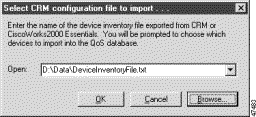
Step 2 Enter the full path and name of the inventory file, or click Browse and select it. Click OK when the correct file is entered.
QPM-PRO opens the Import Devices window and begins querying the devices in the inventory.
While QPM-PRO is querying the devices, you can click Stop to make QPM-PRO stop the query. If you stop the query, QPM-PRO only lets you select from the devices already queried.

Also, you can make other changes in Policy Manager while QPM-PRO queries the devices. When QPM-PRO is finished with the query, you are returned to the Import Devices window to continue the import process.
Step 3 When QPM-PRO has finished querying the devices, select the devices you want to add to the QoS database in the Known Devices list and click >> to add them to the import list. If QPM-PRO could not query a device, do not add the device to the database until you can determine why the query failed.

When you are satisfied with the list of devices to import, click OK.
Step 4 QPM-PRO prompts if you want to detect interfaces on the devices. The interface detection process might take several minutes depending on the number of devices, interfaces, and speed of the network connection.
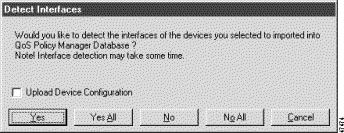
Select one of the following:
You can also upload the device configuration at this time by checking the Upload Device Configuration check box. See Uploading Device QoS Configurations for more information.
When QPM-PRO is finished detecting interfaces, QPM-PRO adds the devices and their interfaces to the tree view and closes the Import Devices window.
You can view a device's properties and change them if required. If you upgrade the software on the device, or replace the device with a new model (while retaining the device's IP addresses), you must update the device properties to ensure that the policies and configurations you create in QPM-PRO are usable on the device.
Step 1 Select the device in the tree view and select Devices>Device>Properties, or right-click the device and choose Device Properties.
QPM-PRO opens the Device Properties window. If you are only viewing the properties, click Cancel when finished.

Step 2 To update the device's properties and its list of interfaces, select the Verify Device Information and Detect Interfaces check boxes and click OK.
QPM-PRO queries the device for its software version and device model information and then obtains a list of interface information, which it displays in the Detect Interfaces window. Select the interfaces you want to manage, deselect those you do not want to manage, and click OK.
To change the Global Settings, click Global Settings Overwrite. The following dialog box appears:
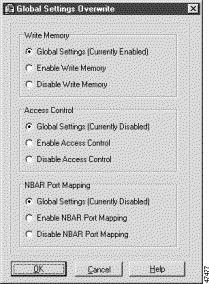
For each setting (Write Memory, Access Control, and NBAR Port Mapping), you can either enable or disable the setting after deployment or maintain global settings by selecting one of the radio buttons. For more information, see Changing Distribution Manager Configuration Settings.
If you no longer want to manage QoS on a device, you can remove it from the QoS database.
Step 1 Right-click the device in the tree view and select Delete Device, or select it and select Devices>Device>Delete.
If any of the device interfaces belong to a device group, a warning message appears and prompts you to confirm the deletion.
If you confirm the deletion, QPM-PRO deletes the device, its interfaces, all associated policy statements, and device group memberships for the device.
You can view the device's software configuration from within QPM-PRO.
Step 1 Select the device in the tree view.
Step 2 Select Devices>Device>View Configuration, or right-click and select View Device Configuration.
QPM-PRO opens a window with the software configuration as defined on the device. See the device's software documentation for information on how to read the configuration.
You can start the Microsoft Telnet program from within QPM-PRO.
Step 1  Select the device you want to connect to and click the Telnet button, or select Tools>Telnet from the Policy Manager.
Select the device you want to connect to and click the Telnet button, or select Tools>Telnet from the Policy Manager.
QPM-PRO starts the Microsoft Telnet program to connect to the device. See the online help for Telnet for information on how to use the program.
The interfaces on a device carry the network traffic. Interfaces can be router interfaces or subinterfaces, or switch ports. You must add the interfaces on which you want to define QoS policies to the QoS database.
These topics describe QPM-PRO tasks for interfaces:
VLANs (Virtual Local Area Networks) are a virtual representation of Local Area Networks. VLANs on Cat6K switches are shown in the tree view, and you can define classification per VLAN. On switch ports, you can choose between port-based QoS or VLAN-based QoS.
Policies can be defined on a port if its QoS style is port-based. Policies can always be defined on a VLAN, but will only be deployed to its ports with VLAN-based QoS style. In deployment, if the port's QoS style is VLAN-based, the VLAN policy is configured. If the port's QoS style is port-based, the port policy is configured. If the port's QoS style is port-based and no policy is defined on the port, no policy is configured. QPM-PRO does not keep the updated information of which port belongs to which VLAN.
When detecting interfaces, QPM-PRO shows all interfaces and VLANs and you can decide which interfaces and VLANs to insert into the database. In the case of VLAN-based classification, you need to define the port's QoS style as VLAN-based. QPM-PRO does not define these automatically; you need to add these interfaces.
You should add a device's interfaces to the database when you add the device. If you subsequently add new interfaces to the device (for example, by installing a new card), be sure to update the device's interface list in the QoS database to reflect the new interfaces.
 |
Note You need to add to the database only those interfaces on which you want to configure QoS. You do not have to add all the device's interfaces. However, to manage subinterfaces, you must also add the associated interface to the database. |
If the device is not yet defined in the QoS database, see the "Adding a Device" section. That procedure includes information on adding the device's interfaces while you add the device.
The following procedures assume that the device is already defined in the database, and that you want to add interfaces to it. If the device is online, it is easiest to add interfaces by having QPM-PRO query the device. This is the automated procedure.
However, if the device is not online, you can manually add the interfaces. To manually add the interfaces, you must first determine the names of the interfaces and their characteristics.
Step 1 Right-click the device in the tree view and select Device Properties.
QPM-PRO opens the Device Properties window.
Step 2 Click Detect Interfaces.
QPM-PRO obtains interface information from the device and opens the Detect Interfaces window.

Step 3 In the Detect Interfaces window, select the devices you want to manage and click >> to move them to the selected devices list. If you do not want to manage a selected interface, select it and click << to remove it from the selected list. When finished, click OK.
QPM-PRO adds the interfaces to the tree view as items in the device's folder. You can now configure QoS on the interface.
Step 1 Select the device whose interface you want to add in the tree view.
Step 2 Select Devices>Interface>New, or right-click and select New Interface.
QPM-PRO opens the New Interface window.

Step 3 Enter the interface properties. See the "New Interface and Properties of Interface Dialog Boxes" section for more information.
You can view the properties of an interface and change them if required.
Step 1 Right-click the interface in the tree view and select Interface Properties, or select the interface and select Devices>Interface>Properties.
QPM-PRO opens the Properties of Interface window. The "New Interface and Properties of Interface Dialog Boxes" section explains each of the settings on this dialog in detail.
If you want to change the interface properties, make your changes in the window and click OK.
If you do not want to manage QoS on an interface, but you still want to manage QoS on other interfaces on the device, you can remove the interface from the QoS database without removing the device. If you remove a card from a device, ensure that you remove the card's interfaces from the QoS database.
Step 1 Right-click the interface in the tree view and select Delete Interface, or select it and select Devices>Interface>Delete.
If the interface belongs to a device group, you are warned and given a chance to confirm the deletion.
If you confirm the deletion, QPM-PRO deletes the interfaces, all associated policy statements, and device group memberships for the interface.
A device group is a group of interfaces that reside on one or more device. You can use device groups to simplify the deployment of your policies, because you can write a policy for the group instead of for each interface separately.
There are two main reasons to group interfaces.
These topics describe device groups in more detail:
You can combine interfaces in a group only if the interfaces are using the same or compatible software version. This ensures that you do not create a policy on the device group that is not supported on one or more interfaces in the group.
When you create a device group, you must state the minimum software version that should be allowed in the device group. QPM-PRO lets you add interfaces to only the groups that use this software version or a version that is compatible with it. QPM-PRO only lets you use QoS properties and policies that are available on all interfaces in the group.
You can include more restrictive characteristics if you desire. For example, you can create a device group that only contains Frame Relay interfaces running IOS software release 12.0.
These tables show the compatibility matrices for software that QPM-PRO can configure:
| Software Version Defined in Device Group | Software Versions That Are Considered Matches |
|---|---|
11.1 | 11.1, 11.1cc, 11.2, 11.3, 12.0, 12.1, 12.1(2)T, 12.1(2)E |
11.1cc | 11.1cc, 12.1 |
11.2 | 11.2, 11.3, 12.0, 12.1, 12.1(2)T, 12.1(2)E |
11.3 | 11.2, 11.3, 12.0, 12.1, 12.1(2)T, 12.1(2)E |
12.0 | 12.0, 12.1, 12.1(2)T, 12.1(2)E |
12.1 | 12.1(2)T |
12.1(2)E |
|
12.1(2)T |
|
| Software Version Defined in Device Group | Software Versions That Are Considered Matches |
|---|---|
5.4 | 5.4, 5.5 |
5.5 | 5.4, 5.5 |
6.1 |
|
6.2 |
|
Create a device group when you want to use identical policies for more than one interface.
Identify the interfaces that you want to treat as a group.
Step 1 From the Policy Manager, select Devices>Device Group>New, or right-click on the Device Groups folder and select New Device Group. QPM-PRO opens the Device Group window.
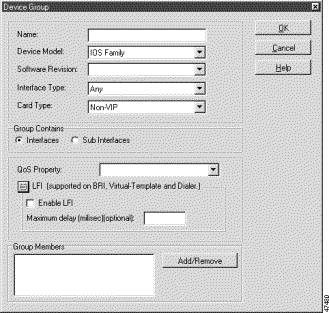
Step 2 Fill in the fields in the Device Group window (see the "Device Group Dialog Box" section for more information).
If you are creating a device group to define a common QoS property, set the desired property in the QoS property field. Otherwise, set the QoS property to Defined by interface.
Step 3 In the Device Group window, click Add/Remove in the Group Members group.
QPM-PRO opens the Add/Remove Group Members window.
Step 4 In the Add/Remove Group Members window, select the desired interfaces in the Available Interfaces list and click >>.
The Available Interfaces list includes only interfaces that:
Click OK when you finish adding interfaces. QPM-PRO returns you to the Device Groups window.
Step 5 Click OK in the Device Groups window.
QPM-PRO adds the device group to the Device Groups folder in the tree view. You can now select the group and add policies to it.
After you define a device group, you can add members to the group or remove them from the group.
If you want to add an interface to a device group, and the interface is currently running an incompatible version of the device's software than the one defined for the group, you must upgrade the software on the device before you can add the interface to the group.
Step 1 From the Policy Manager, select the device group in the tree view and select Devices>Device Group>Add/Remove Members, or right-click the group and select Add/Remove Members.QPM-PRO opens the Add/Remove Group Members window.
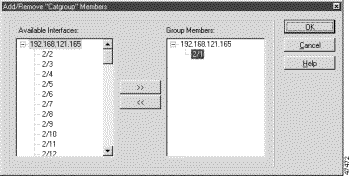
Step 2 If you are adding members, select the desired members in the Available Interfaces list and click >>. This list contains only interfaces that satisfy the device group characteristics and that do not already belong to a group.
If you are removing members, select the members in the Group Members list and click <<.
Modify a device group when you want to add or remove interfaces, or change other properties for the group.
You can only change these properties of a device group:
If you want to change the Software Revision or Device Model properties, you must create a new device group. Changing these properties might invalidate policies that you have defined and distributed to the members of the group.
Step 1 From the Policy Manager, select the device group in the tree view and select Devices>Device Group>Properties. QPM-PRO opens the Device Group window.
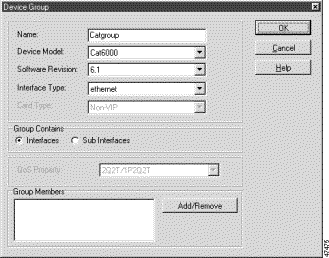
Step 2 Make the desired changes to the device group properties (see the "Device Group Dialog Box" section for more information).
Every feature has a +/- button to display and hide the feature's parameters. Click + to display the feature's parameters. You can enable or disable the feature and specify its parameters.
In QPM-PRO, when the interface is selected, the interface property preview is shown in the lower part of the window. The preview includes:
Delete a device group when you no longer want to treat the group of interfaces as a group. However, if you only want to remove some of the members of the group, you do not need to delete the group. See the "Adding or Removing Device Group Members" section for more information.
Step 1 From the Policy Manager, select the device group in the tree view.
Step 2 Select Devices>Device Group>Delete, or right-click and select Delete Device Group.
QPM-PRO asks you to confirm the deletion.
When you delete a device group, the group's QoS property and associated policies (for example, policies that create priority or custom queues) are copied to the interfaces that were members of the device group. You are asked whether other policies defined on the group, such as coloring or shaping policies, should be copied to interfaces that you are removing. If you click Yes or Yes to All, the policies are copied, meaning there is no change to the services provided by the interface. If you click No, the policies are not copied to the interface, changing the services provided by the interface.
When you create a device group, you specify the minimum software version allowed for members of the group. Because you specify a minimum version level, you can upgrade your devices without affecting QPM's deployment of policies to the devices.
However, if you downgrade the software version on a member of a group to a version incompatible with the minimum version, you can encounter problems. If your policies, or QoS property, for the interface is incompatible with the QoS capabilities of the software version, you will see errors in Policy Manager when you try to reverify the device information for the upgraded device. At that time, you will have to remove the interface from the group; otherwise, you will see errors in Distribution Manager when you try to deploy policies to the device group.
If you need to downgrade the software version on a device, make sure you remove the device's interfaces from device groups that require an incompatible version of the software.
![]()
![]()
![]()
![]()
![]()
![]()
![]()
![]()
Posted: Tue Oct 1 12:55:38 PDT 2002
All contents are Copyright © 1992--2002 Cisco Systems, Inc. All rights reserved.
Important Notices and Privacy Statement.